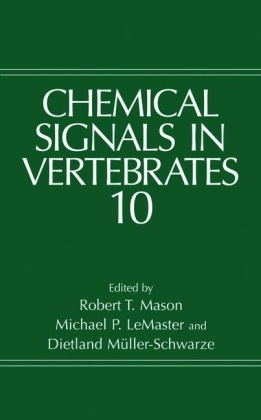Mehr lesen
This volume is comprised of the proceedings of Chemical Signals in Vertebrates 10, held July 29th through August 1st, 2003 at Oregon State University in Corvallis, Oregon, USA. The volume includes the state-of-the-art in chemical signaling among vertebrates.
Inhaltsverzeichnis
Thirty years on the odor trail: From the first to the tenth international symposium on chemical signals in vertebrates -Pheromones: Convergence and contrasts in insects and vertebrates -The discovery and characterization of splendipherin, the first anuran sex pheromone -Chemically mediated mate recognition in the tailed frog -Responses to sex and species specific chemical signals in allopatric and sympatric salamander species -The pheromonal repelling response in red spotted newts -The effects of cloacal secretions on brown tree snake behavior -Species and sub species recognition in the North American beaver -Self grooming in meadow voles -Protein content of male diet does not influence proceptive behavior in female meadow voles - The signalin of competitive ability by male house mice -A possible function for female enurination in the mara - The evolution of perfume-blending and wing sacs in emballonurid bats -Behavioral responsiveness of captive giant pandas -Chemical signals in giant panda urine -Chemical communication of musth in captive Asian elephants -Chemical analysis of preovulatory female African elephant urine: A search for putative pheromones -Assessing chemical communication in elephants -The gland and the sac the preorbital apparatus of muntjacs - The chemistry of scent marking in two lemurs -Soiled bedding from group-housed females exerts strong influence on male reproductive condition - The role of the major histocompatibility complex in scent communication -Characterization of proteins in scent marks; proteomics meets semiochemistry -The 'scents' of ownership -The role of scent in inter-male aggression in house mice & laboratory mice -Chemical signals and vomeronasal system function in axolotls -From the eye to the nose: ancient orbital to vomeronasal co mmunication in tetrapods -Prey chemical signal transduction in the vomeronasal system of garter snakes -Mode of delivery of prey-derived chemoattractants to the olfactory and vomeronasal epithelia
Zusammenfassung
The editors and contributors to this volume should be justifiably proud of their participation in the tenth triennial meeting of the Chemical Signals in Vertebrates International Symposium. This meeting was held 27 years after the initial gathering of participants in Saratoga Springs, New York from June 6* to 9*, 1976. Subsequent meetings have been held every three years in Syracuse, New York; Sarasota, Florida; Laramie, Wyoming; Oxford, England; Philadelphia, Pennsylvania; Tubingen, Germany; Ithaca, New York; and Krakow, Poland. This tenth aimiversary symposium was held from July 29* through August 1*' in Corvallis, Oregon and was hosted by the Zoology Department and Biology Programs of Oregon State University. This book also represents the tenth in a series of books on chemical communication, chemical ecology, olfactory and vomeronasal research in vertebrate species. The species covered in the chapters herein range from fish to mammals including humans. By taxonomic breakdown the mammals are the most represented in number of species and chapter contributions. However, the hosts of the meeting endeavored to have some representative contributions covering all of the major vertebrate taxa. As in past years, the meeting was well-represented with just over 100 participants from 13 different nations. Plenary talks focused on some of the non-mammalian groups that have tended to be less represented in these symposia. Thus, we had a very nice overview of comparisons and contrasts of invertebrate chemical commimication to vertebrate systems.

